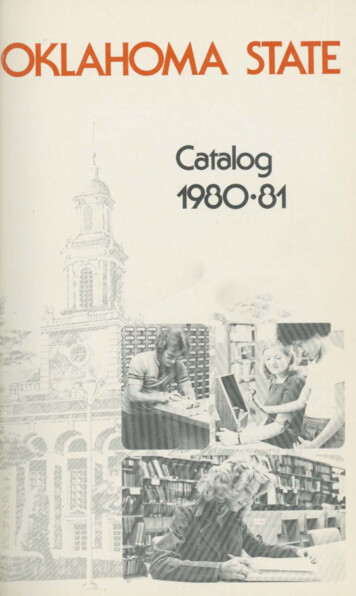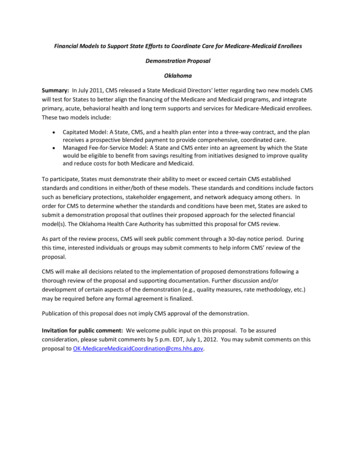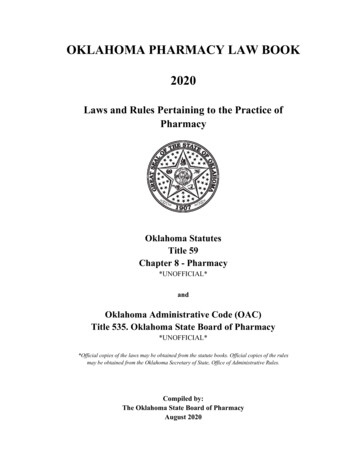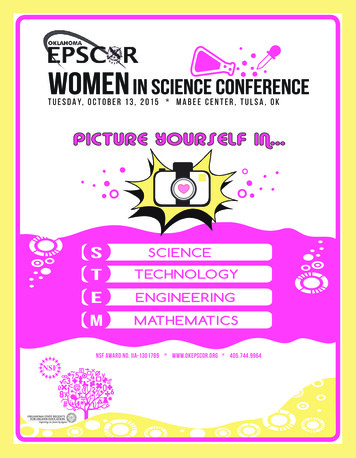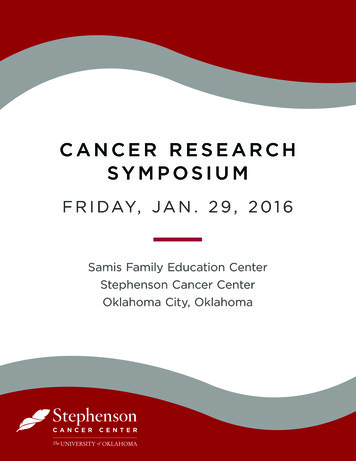
Transcription
CANCER homa
The Stephenson Cancer Center wishes to recognize and thank the Oklahoma TobaccoSettlement Endowment Trust (TSET) for co-sponsoring the 2016 Stephenson Cancer ResearchSymposium.In 2012 TSET awarded a five-year, 30.25 million grant to the Stephenson Cancer Center toestablish the Oklahoma TSET Cancer Research Program.The mission of the Oklahoma TSET Cancer Research Program is to decrease the burden ofcancer in Oklahoma and nationally through promoting, coordinating and supporting innovativecancer research. It seeks to accomplish this mission through: Attracting cancer researchers with grant funding from the National Cancer Institute andother national sponsors to OklahomaDeveloping trans-disciplinary, collaborative cancer research programsPromoting inter-institutional partnerships to leverage unique strengths at researchinstitutions in OklahomaEnhancing research infrastructure and shared resources to enable and supportinnovative and nationally-competitive cancer researchServing as a statewide resource for researchers and institutions that conduct cancerresearchThe Oklahoma TSET Cancer Research Program supports a wide range of programs, sharedresources and initiatives designed to accomplish these goals.FY 15 HighlightsWith support from the Oklahoma TSET Cancer Research Program the Stephenson Cancer Centeraccomplished the following in FY 15: Increased cancer center membership by 23% (183 to 226 members) at ten academicinstitutions across OklahomaRecruited seven new cancer researchers to OklahomaSecured 31.1 million in total grant funding related to cancer and tobacco preventionand control researchFunded 13 seed and directed-research grants to cancer investigators in Oklahoma
Enhanced five Shared Resource facilities: Biospecimen Acquisition Core and Bank,Biostatistics, Cancer Functional Genomics, Cancer Tissue Pathology, and MolecularImagingHosted over 32 research seminar speakersHosted its 4rd Annual statewide Cancer Research Symposium that brought togetherover 250 researchers from around the stateHosted ten undergraduate students from eight different universities for a summercancer research experienceOpened 142 new cancer clinical trialsEnrolled 565 patients to interventional clinical trialsEnrolled 480 patients to cancer treatment trialsOpened 24 new Phase I and Phase I/II clinical trialsEnrolled 133 patients to Phase I clinical trialsCancer Research
Stephenson Cancer Center wishes to recognize and thank the Oklahoma Tobacco ResearchCenter (OTRC) for co-sponsoring the 2016 Stephenson Cancer Research Symposium.About the Oklahoma Tobacco Research Center:The mission of the Oklahoma Tobacco Research Center (OTRC) is to build a robust, interdisciplinary center that will reduce the burden of tobacco-related cancers and other diseases inOklahoma’s most vulnerable populations. To achieve this mission, the OTRC engages local,state, tribal and national partners to address the following goals:1. Build and sustain a research program that spans the entire translational research continuumand includes: 1) the development of novel interventions through engagement with communitypartners; 2) the elucidation of key mechanisms underlying tobacco dependence; and 3) thedissemination and implementation of research findings to high need communities in Oklahoma.2. To efficiently and effectively deliver evidence-based tobacco treatment to smokers inOklahoma.3. To provide tobacco policy expertise to help inform decision makers in Oklahoma.4. To develop and sustain a robust comprehensive tobacco research training program forundergraduate, graduate, and medical students and postdoctoral fellows.In addition, the OTRC provides tobacco cessation services across the state through its TobaccoDependence Treatment Program, and educates and trains health providers in state-of-the-artcessation services.The OTRC was established in 2007 with funding from the Oklahoma Tobacco SettlementEndowment Trust (TSET). Recognizing the investments that TSET has made in statewide andcommunity-based cessation and intervention projects, a key feature of the OTRC is establishingpartnerships with existing and future TSET-funded projects and the Oklahoma StateDepartment of Health (OSDH) tobacco-related programs. Those partnerships directly link OTRCresearchers with tobacco-related issues and initiatives in Oklahoma.OTRC Director:OTRC Associate-Directors:Jennifer Vidrine, PhDSteven Gillaspy, PhDD. Robert McCaffree, MD, MSHADamon Vidrine, DrPHTheodore Wagener, PhD
ContentsSchedule & Agenda2Cancer Health Disparities: Keynote and Guest Speakers Biographies9Oral Presentation Abstracts14Session I15Session II21Session III28Session IV36Session V42Poster Presentation Abstracts50Stephenson Cancer Center Shared Resources1341
Schedule & Agenda2
Cancer Research Symposium Schedule at a Glance7:30 - 8:30 a.m.Registration, Continental Breakfast and Poster Set Up8:20 - 8:30 a.m.Welcome and Opening Remarks8:30 - 8:40 a.m.Break8:40 - 9:40 a.m.Concurrent Session I9:40 - 10:40 a.m.Concurrent Session II10:40 - 10:50 a.m.Break10:50 - 11:50 a.m.Stephenson Cancer Center Update11:50 - 1:30 p.m.Lunch and Poster Viewing1:30 - 2:30 p.m.Concurrent Session III2:30 - 3:30 p.m.Concurrent Session IV3:30 - 3:45 p.m.Break3:45 - 4:45 p.m.Concurrent Session V4:45 - 5:00 p.m.Break5:00 - 5:15 p.m.Awards and Closing Remarks5:15 - 6:30 p.m.Reception3
Cancer Research Symposium Concurrent Session AgendaBasic / Translational / Clinical Track (B / T / C)Cancer Health Disparities and Control Track (CHD)8:40-9:40 a.m. CONCURRENT SESSION IB/T/CCELL SIGNALINGModerator: Ralf Janknecht, PhD & Jie Wu, PhD8:40-8:55MICROVESICLES IN B CELL CHRONIC LYMPHOCYTIC LEUKAMIAIMPLICATION IN DISEASE PROGRESSIONAsish Ghosh, PhDDepartment of PathologyUniversity of Oklahoma Health Sciences Center8:55-9:10THE ROLE OF TMEFF2 IN PROSTATE CANCER HETEROGENEITY ANDTUMOR BIOLOGYMaria Ruiz-Echevarria, PhDDepartment of PathologyUniversity of Oklahoma Health Sciences Center9:10-9:25DNA METHYLATION ANALYTICAL TOOLBOX FOR STUDIES OF VIRALINDUCED CANCERSWillard Freeman, PhDDepartment of PhysiologyUniversity of Oklahoma Health Sciences Center9:25-9:40MODELING RET FUSION IN LUNG ADENOCARCINOMAJie Wu, PhDDepartment of PathologyUniversity of Oklahoma Health Sciences CenterCHDCANCER HEALTH DISPARITIES KEYNOTE ADDRESSModerator: Mark Doescher, MD, MSPH8:40-9:40ADVANCING TOBACCO CONTROL POLICY TO REDUCE CANCERHEALTH DISPARITIES: PROGRESS AND PROMISEScott J. Leischow, PhDLevel TwoAuditoriumLevel BB3ProfessorCo-Director, Cancer Prevention and Control, Mayo Clinic Cancer CenterDirector, Research on Healthy Equity and Community Health, Office of4
Health Disparities Research9:40-10:40 a.m. CONCURRENT SESSION IIB/T/CCANCER NANOMEDICINEModerator: Rajagopal Ramesh, PhD & Priyabrata Mukherjee, PhD9:40-10:00AN OPTICAL IMAGE-GUIDED PRODRUG STRATEGY USING ACOMBINATION OF PHOTODYNAMIC THERAPY AND SITE –SPECIFICCHEMOTHERAPYYoungjae You, PhDDepartment of PharmacyUniversity of Oklahoma Health Sciences Center10:00-10:20MOLECULAR-TARGETED IMAGING TO ASSESS EITHER ANGIOGENESIS,EARLY DETECTION OF METASTASIS IN DIFFERENT PRE-CLINICALCANCER MODELSRheal Towner, PhDAdvanced Magnetic Resonance CenterOklahoma Medical Research Foundation10:20-10:40PHAGE-ENABLED CANCER DIAGNOSIS AND THERAPYChuanbin Mao, PhDDepartment of Chemistry and BiochemistryUniversity of OklahomaCHDCANCER HEALTH DISPARITIES GUEST SPEAKERSModeration: Mark Doescher, MD, MSPH9:40-10:10THE ECONOMICS OF TOBACCO TAXATION IN OKLAHOMAFrank Chaloupka, PhDDirector, Health Policy CenterUniversity of Illinois – Chicago10:10-10:40CALIFORNIA HIGH TECH CIGARETTE TAX STAMP: PROCESS ANDBENEFITSWilliam P. Kimsey, CPABusiness Taxes AdministratorCalifornia State Board of Equalization10:50-11:50STEPHENSON CANCER CENTER UPDATERobert Mannel, MDDirector, Stephenson Cancer CenterLevel TwoAuditoriumLevel BB3Level TwoAuditorium5
1:30-2:30 p.m. CONCURRENT SESSION IIIB/T/CPANCREATIC CANCERModerator: Min Li, PhD1:30-1:42OVEREXPRESSION OF DCLK1 IN PANCREATIC CANCER ACTIVATESKRAS/PI3K/mTOR PATHWAY SIGNALING AND SUPPORTSTUMORIGENESIS, INVASIVENESS, AND STEMNESSDongfeng Qu, PhDDepartment of MedicineUniversity of Oklahoma Health Sciences Center1:42-1:54ENHANCED PANCREATIC TUMOR PROGRESSION IS REGULATED BYNATURAL KILLER T (NKT) CELLS DEPENDENT ON mPGES-1 IN TUMORASSOCIATED MACROPHAGESNaveena Janakiram, PhDDepartment of Hematology and OncologyUniversity of Oklahoma Health Sciences Center1:54-2:06REPRESSION OF p38 PATHWAY AND CACHEXIA UNDERLIES ZIP4REGULATION OF POST-SURGICAL SURVIVAL OF PANCREATIC CANCERJingxuan Yang, PhDDepartment of Internal MedicineUniversity of Oklahoma Health Sciences Center2:06-2:18PROTOCOL FOR A TRANSLATIONAL RTC: PREOPERATIVE EXERCISEAND NUTRITION TO IMPROVE PANCREATIC CANCER OUTCOMES BYTARGETING SARCOPENIAElizabeth Hile, PhD, PTDepartment of Rehabilitation SciencesUniversity of Oklahoma Health Sciences Center2:18-2:30MACROPINOCYTOSIS AND PANCREATIC CANCERXunhao Xiong, PhDDepartment of PathologyUniversity of Oklahoma Health Sciences CenterCHDIMPROVING TRIBAL FOOD ENVIRONMENTSModerator: Damon Vidrine, DrPHLevel TwoAuditoriumLevel BB36
1:30-2:15POLICY AND ENVIRONMENTAL STATEGIES TO IMPROVE TRIBAL FOODENVIRONMENTS: THE THRIVE STUDYValerie Blue Bird Jernigan, DrPH, MPHCollege of Public HealthUniversity of Oklahoma Health Sciences Center2:15-2:30QUESTION AND ANSWER PANELBobby Saunkeah, Chickasaw NationMichael T. Peercy, Choctaw Nation2:30-3:30 p.m. CONCURRENT SESSION IVB/T/CTRANSLATIONAL CANCER BIOLOGY - PART IModerator: Xin Zhang, MD, PhD2:30-2:50TARGETING INFLAMMATION BLOCKS TUMOR INITIATING STEM CELLSAND PANCREATIC CANCER PROGRESSIONAltaf Mohammed, PhDDepartment of MedicineCenter for Cancer Prevention and Drug DevelopmentUniversity of Oklahoma Health Sciences Center2:50-3:10NEXT GENERATION IMAGE GUIDED DRUG DELIVERY USINGULTRASOUND IMAGEABLE LIPOSOMES AND HIGH INTENSITYFOCUSED ULTRASOUND FOR ENHANCED CHEMOTHERAPYPENETRATION IN SOLID TUMORSAshish Ranjan, PhDDepartment of Physiological SciencesOklahoma State University3:10-3:30PANCREATIC CYSTIC NEOPLASMS: A SINGLE INSTITUTION EXPERIENCEAlessandra Landmann, MDDepartment of SurgeryUniversity of Oklahoma Health Sciences CenterCHDUSING mHEALTH TO REACH UNDERSERVED POPULATIONSModerator: Damon Vidrine, DrPH2:30-3:30USING mHEALTH TO ADDRESS CANCER RELATED HEALTH DISPARITIESMichael Businelle, PhD & Darla Kendzor, PhDDepartment of Family and Preventative MedicineUniversity of Oklahoma Health Sciences CenterLevel TwoAuditoriumLevel BB33:45-4:45 p.m. CONCURRENT SESSION V7
B/T/CTRANSLATIONAL CANCER BIOLOGY – Part IIModerator: Zhizhuang (Joe) Zhao, PhD3:45-4:05TRANSCRIPTIONAL REARRANGEMENT OF RETINAL DEGENERATIONPROTEIN 3 (RD3) ORCHESTRATES MYCN INDEPENDENTNEUROBLASTOMA EVOLUTIONNatarajan Aravindan, PhDDepartment of Radiation OncologyUniversity of Oklahoma Health Sciences Center4:05-4:25UNCOVERING THE ROLE OF XRN2 IN GENOMIC INSTABILITY AND THEDNA DAMAGE RESPONSEJulio Morales, PhDDepartment of NeurosurgeryUniversity of Oklahoma Health Sciences Center4:25-4:45INHIBITION OF BMI1 INDUCED AUTOPHAGY MEDIATED NECROPTISISAnindya Dey, PhDDepartment of Obstetrics and GynecologyUniversity of Oklahoma Health Sciences CenterCHDSELECTED RESEARCH PRESENTATIONSModerator: Damon Vidrine, DrPH3:45-4:05THE ASSOCIATION OF WNT/BETA-CATENIN SIGNALING ACTIVATIONAND MODIFIABLE RISK FACTORS IN OROPHARYNGEAL CANCERLacy BrameDepartments of Otorhinolaryngology and Biostatistics andEpidemiologyUniversity of Oklahoma Health Sciences Center4:05-4:25TRENDS IN LUNG AND BRONCHOUS, PROSTATE, FEMALE BREAST,AND COLON AND RECTUM CANCERS INCIDENCE AND MORTALITY INOKLAHOMA AND THE UNITED STATES FROM 1999-2012C. Larry Hill, Jr.Department of Biostatistics and EpidemiologyUniversity of Oklahoma Health Sciences Center4:25-4:45NALOZONE ADMINISTRATION AMONG CANCER PATIENTS BY EMS INOKLAHOMA, 2011 TO 2014Johnnie L. Gilpen, Jr. MS, NREMT-I, GISPOklahoma State Department of HealthLevel TwoAuditoriumLevel BB38
Cancer Health DisparitiesKeynote and Guest SpeakersBiographies9
Scott J. Leischow, PhDProfessorCo-Director, Cancer Prevention and Control, Mayo Clinic Cancer CenterDirector, Research on Health Equity and Community Health, Office of Health Disparities ResearchScott J. Leischow, Ph.D. joined the Mayo Clinic in 2012, where he leads Risk Reduction Research withinthe Mayo Clinic Cancer Center and Research on Health Equity and Community Engagement Program atthe Mayo Clinic Arizona. He was formerly Associate Director at the University of Arizona Cancer Center,and before that served as Senior Advisor for Tobacco Policy in the US Department of Health and HumanServices and Chief of the Tobacco Control Research Branch at the National Cancer Institute of NIH. Dr.Leischow completed his doctorate in Health Education from the University of Maryland, and apostdoctoral fellowship in Behavioral Pharmacology from Johns Hopkins University. Dr. Leischow hasreceived several awards, including the NIH Director’s Award. Most of Dr. Leischow’s research andpublications focus on pharmacologic and behavioral treatments for tobacco dependence, systems andnetwork approaches to public health, and the analysis of social media regarding tobacco control. Healso created the Arizona Smokers Helpline, and played a leadership role in establishing the nationalnetwork of smoking cessation quitlines in the United States. Dr. Leischow is past President of the Societyfor Research on Nicotine and Tobacco (SRNT).10
Frank Chaloupka, PhDDirectorHealth Policy CenterUniversity of Illinois-ChicagoFrank J. Chaloupka is a Distinguished Professor at the University of Illinois at Chicago, where he has beenon the faculty since 1988. He is currently Director of the UIC Health Policy Center and holdsappointments in the College of Liberal Arts and Sciences’ Department of Economics and the School ofPublic Health’s Division of Health Policy and Administration. He is a Fellow at the University of Illinois’Institute for Government and Public Affairs, and is a Research Associate in the National Bureau ofEconomic Research’s Health Economics Program and Children’s Program. Dr. Chaloupka is Director ofthe WHO Collaborating Centre on The Economics of Tobacco and Tobacco Control, Director ofImpacTeen: A Policy Research Partnership for Healthier Youth Behavior and Co-Director of theInternational Tobacco Evidence Network. An economist, Dr. Chaloupka earned his B.A. from John CarrollUniversity in 1984 and his Ph.D. from the City University of New York Graduate School and UniversityCenter.Numerous professional publications and presentations have resulted from Dr. Chaloupka's research onthe effects of prices and substance control policies on cigarette smoking and other tobacco use, alcoholuse and abuse, and illicit drug use, as well as on various outcomes related to substance use and abuse.Much of this research has focused on youth and young adults. This research has been funded by theNational Cancer Institute, the National Institute on Alcohol Abuse and Alcoholism, the National Instituteon Drug Abuse, the Centers for Disease Control and Prevention, The Robert Wood Johnson Foundation,the Rockefeller Foundation, the Bloomberg Philanthropies, the Bill and Melinda Gates Foundation, andothers. Dr. Chaloupka contributed a section on the effects of cigarette taxes and prices on youth smokingfor the 1994 Surgeon General’s report, and a lengthy chapter on the economics of tobacco for the 2000Surgeon General’s report on which he was Consulting Scientific Editor. In addition, he co-authored theWorld Bank’s policy report: Curbing the Epidemic: Governments and the Economics of Tobacco Control andco-edited the volume Tobacco Control in Developing Countries containing the background papers preparedfor the report. He is currently updating this work as lead editor for the forthcoming NCI and WHOmonograph on The Economics of Tobacco and Tobacco Control, was part of the editorial team for the 2012Surgeon General’s report on Preventing Tobacco Use Among Youth and Young Adults, and chaired theInternational Agency for Research on Cancer's working group that produced the 2011 IARC HandbookEffectiveness of Tax and Price Policies for Tobacco Control. Over the past few years, Dr. Chaloupka’sresearch on the policy and economic determinants of health behaviors has expanded to include a focuson healthy eating, physical activity, and obesity. Some of this research is highlighted in the October 2007supplement to the American Journal of Preventive Medicine for which Dr. Chaloupka was the lead editor.Dr. Chaloupka is on the editorial boards of American Journal of Preventive Medicine, JAMA Pediatrics, andContemporary Economic Policy, is the economics editor for Tobacco Control, an Assistant Editor forAddiction, and an Associate Editor for Nicotine & Tobacco Research. He is a consultant to numerousgovernmental agencies, private organizations, and businesses. In 1996 Dr. Chaloupka received the11
University Scholar Award from the University of Illinois for his research on the economic analysis ofsubstance use and abuse, in 2009 received UIC’s first Researcher of the Year in the Social Sciences andHumanities award for his work on the economic, policy and environmental determinants of healthbehavior, in 2011 received the Society for Research on Nicotine and Tobacco's John Slade Award, and in2015 received the American Cancer Society's Luther Terry Award for Exemplary Leadership in TobaccoControl for Outstanding Research Contribution.12
William P. Kimsey, CPABusiness Taxes AdministratorCalifornia State Board of EqualizationBill Kimsey has worked for the Board of Equalization for over 35 years in audit. Of those 36 years, heworked in management for 26 years in the Special Taxes and Fees Department. Mr. Kimsey was directlyinvolved in the State’s transition to the new alternative cigarette tax stamp that is encrypted withsecurity features and has significantly decreased California’s problems with counterfeit cigarette taxstamps. Currently, as a Branch Manager in the Appeals and Data Analysis Branch, Mr. Kimsey overseesall Appeals and Data Analysis functions for 28 taxes and fees programs, including excise taxes, fuel taxes,and environmental fees. These functions include processing various types of petitions, administrativeprotests, and refunds and analyzing external data for audit purposes. He also oversees the branch’sresponsibilities for the current California cigarette tax stamp and for the Master Settlement Agreementin preparing various reports for the California State Attorney General’s Office.13
Concurrent Sessions:Information&Abstracts14
Concurrent Session I – Basic / Translational / Clinical8:40 a.m. – 9:40 a.m.Level Two, AuditoriumCELL SIGNALINGModerator: Ralf Janknecht, PhD & Jie Wu, PhD8:40 a.m. – 8:55 a.m.MICROVESICLES IN B CELL CHRONIC LYMPHOCYTIC LEUKEMIA:IMPLICATION IN DISEASE PROGRESSIONAsish Ghosh, PhDDepartment of PathologyUniversity of Oklahoma Health Sciences center8:55 a.m. – 9:10 a.m.THE ROLE OF TMEFF2 IN PROSTATE CANCER HETEROGENEITYAND TUMOR BIOLOGYMaria Ruiz-Echevarria, PhDDepartment of PathologyUniversity of Oklahoma Health Sciences Center9:10 a.m. – 9:25 a.m.DNA METHYLATION ANALYTICAL TOOLBOX FOR STUDIES OFVIRAL-INDUCED CANCERSWillard Freeman, PhDDepartment of PhysiologyUniversity of Oklahoma Health Sciences Center9:25 a.m. – 9:40 a.m.MODELING RET FUSION IN LUNG ADENOCARCINOMAJie Wu, PhDDepartment of PathologyUniversity of Oklahoma Health Sciences Center15
MICROVESICLES IN B CELL CHRONIC LYMPHOCYTIC LEUKEMIA-IMPLICATION IN DISEASE PROGRESSIONPRESENTER: Asish GhoshAsish K. Ghosh, PhDDepartment of Pathology, University of Oklahoma Health Sciences CenterMicrovesicles (MVs) released by malignant cancer cells constitute an important part of the tumormicroenvironment. They can transfer various messages to target cells and may be critical to diseaseprogression. Here, we demonstrate that MVs circulating in plasma of B-cell chronic lymphocyticleukemia (CLL) patients exhibit a phenotypic shift from predominantly platelet derived in early stage toleukemic B-cell derived at advanced stage. Furthermore, the total MV level in CLL was significantlygreater compared with healthy subjects. To understand the functional implication, we examinedwhether MVs can interact and modulate CLL bone marrow stromal cells (BMSCs) known to provide a“homing and nurturing” environment for CLL B cells. We found that CLL-MVs can activate theAKT/mammalian target of rapamycin/p70S6K/hypoxia inducible factor-1α axis in CLL- BMSCs withproduction of vascular endothelial growth factor, a survival factor for CLL B cells. Moreover, MVmediated AKT activation led to modulation of the β-catenin pathway and increased expression of cyclinD1 and c-myc in BMSCs. We found MVs delivered phospho-receptor tyrosine kinase Axl directly to theBMSCs in association with AKT activation. This study demonstrates the existence of separate MVphenotypes during leukemic disease progression and underscores the important role of MVs inactivation of the tumor microenvironment.16
THE ROLE OF TMEFF2 IN PROSTATE CANCER HETEROGENEITY AND TUMOR BIOLOGYPRESENTER: Maria J. Ruiz-EchevarríaJoshua M. Corbin, Sandra Thibivilliers, Maria J. Ruiz-EchevarríaDepartment of Pathology, Stephenson Cancer Center, University of Oklahoma Health Sciences CenterProstate cancer (PCa) is the second leading cause of cancer death in American men. Although themajority of PCa cases remain indolent, 10% of the cases progress to lethality with metastases and thesubsequent emergence of therapy-resistant disease. Identifying those cancers that require aggressivetreatment and developing lasting therapies for advanced disease are therefore the most crucial needs inthe clinical management of PCa. The failure of current prognostic indicators to accurately stratify diseaserisk reflects, in part, the genomic heterogeneity of this disease; patients with similar pathologicaloutcomes (Gleason score, PSA level) may demonstrate disparate therapeutic responses/mortality rates.Importantly, this intertumor variability has proven valuable in identifying cancer-related driver genes inother cancers, which are either upregulated or downregulated, and therefore demonstrate a highervariation across tumors.TMEFF2 has recently been identified as one of the most variably expressed genes in PCa, a finding thatsuggests that its expression may correlate with the variable clinical outcome of this disease. Ourlaboratory has identified TMEFF2 as a tumor suppressor in PCa that functions as a modulator of onecarbon metabolism, and of cell motility. Here we further explore the clinical relevance of TMEFF2 and itsrole in PCa. Using bioinformatics analysis of existing databases, we found that low TMEFF2 expression isassociated with significantly shorter disease-free survival (median of 20 vs. 110 months; logrank testP 6.5X10-4). Also, loss of TMEFF2 expression appears more prevalent in metastatic disease as comparedwith primary tumors, raising the possibility that its downregulation may predispose and perhaps predictthe development of metastatic disease. Importantly, studies in cell lines indicate that, related to its rolein modulating one-carbon metabolism, low TMEFF2 levels sensitize the cell to methotrexate, an antifolate chemotherapeutic drug. Relevant to its role in PCa, expression of TMEFF2 is regulated by theandrogen-receptor (AR), a nuclear receptor essential in prostate homeostasis and PCa development andprogression. TMEFF2 affects the transcriptional activity of the AR, indicating that TMEFF2 is not only atarget but also a co-regulator of the AR. In support of this role, results obtained with a transgenicTMEFF2 mouse model developed in our lab indicate that TMEFF2 modulates prostate branchingmorphogenesis during regeneration, a developmental process controlled by AR/androgen signaling.Together these data support the clinical significance of TMEFF2 and its potential as a biomarker, andvalidate the need to further understand its role in PCa. These studies provide new potential avenues forPCa therapeutic intervention and risk stratification.17
DNA METHYLATION ANALYTICAL TOOLBOX FOR STUDIES OF VIRAL-INDUCED CANCERSPRESENTER: Willard FreemanWillard M. Freeman, PhDDonald W. Reynolds Chair in Aging ResearchAssociate Professor of PhysiologyAdjunct Associate Professor of Geriatric MedicineMember, Harold Hamm Diabetes InstituteAssociate Member, Stephenson Cancer CenterThe concept that cancer is a disease of epigenetic as well as genetic abnormalities has been wellvalidated. Alterations in the epigenetic patterns of genomes including 5-methylcytosine in CG and nonCG dinucleotide contexts is a common hallmark of human cancer and may be a key regulator ofoncogenes. Viral DNA CpG methylation, as well as host genetic, epigenetic, transcriptome and oncogenealterations are observed with HPV infections. While significant advances have been made in the nextgeneration sequencing methods for analysis of DNA modifications, bringing these to practice requiresanother generation of method development. We have developed a three tiered approach for absolute,base- and strand-specific analysis of DNA methylation of small viral and large host genomes. Thisapproach uses whole genome bisulfite sequencing (WGBS), Bisulfite Oligonucleotide CaptureSequencing (BOCS), and Bisulfite Amplicon Sequencing (BSAS) for analysis of gigabases, megabases, andkilobases of genomes respectively. Examples of each of these methods will be presented. These toolsare available to the entire SCC research community.18
MODELING RET FUNSION IN LUNG ADENOCARCINOMAPRESENTER: Jie WuJie Wu, PhDDepartment of Pathology, University of Oklahoma Health Sciences CenterRecurrent RET fusions have been found lung adenocarcinoma. Among them KIF5B-RET fusion is the mostprevalent. To develop an animal model for evaluation of KIF5B-RET fusion in lung adenocarcinoma, wegenerated transgenic mice containing a doxycycline-inducible tetO-KIF5B-RET transgene. Induction ofCCSP-rtTA/tetO-KIF5B-RET bitransgenic mice with doxycycline resulted in MRI- and CT-detectable lungadenocarcinoma in 4-5 months. KIF5B-RET-induced lung adenocarcinoma is characterized bydesmoplastic reaction. Desmoplasia is associated with invasive lung adenocarcinoma and is found inhuman RET-fusion-positive lung adenocarcinoma, but it has not been observed in transgenic mousemodels of EGFRL858R-, KrasG12D-, or PTPN11E76K-induced lung adenocarcinoma. Using MRI, CT, andhistological examinations, we evaluated oncogene dependency and the response to the multikinase RETinhibitor ponatinib in KIF5B-RET-induced lung tumors. Tumors regressed one month after Doxwithdrawal or ponatinib treatment. Thus, we have established a transgenic mouse model of KIF5B-RETinduced lung adenocarcinoma. The KIF5B-RET-induced lung tumors are associated with desmoplasia,depend on KIF5B-RET for maintaining the malignant phenotype, and respond to ponatinib treatment.19
Concurrent Session I – Cancer Health Disparities8:40 a.m. – 9:40 a.m.Level B, Room B3KEYNOTE ADDRESSADVANCING TOBACCO CONTROL POLICY TO REDUCE CANCER HEALTHDISPARITIES: PROGRESS AND PROMISEScott J. Leischow, PhDProfessorCo-Director, Cancer Prevention and Control, Mayo Clinic Cancer CenterDirector, Research on Health Equity and Community Health, Office of Health Disparities ResearchThis presentation will discuss the relationship between tobacco related and cancer related healthdisparities in the United States. Considerable evidence shows that disparities exist regarding tobacco usein areas related to, ethnicity, socioeconomic status, mental health status and sexual orientation. Forexample, American Indians have the highest prevalence of tobacco use relative to other ethnicminorities, and American Indian lung cancer mortality is highest in those regions of the US whereAmerican Indian smoking rates are highest. Similar cancer health disparities also exist, evidenced byhigher rates of lung cancer mortality among African American men than men of other racial/ethnicgroups. This presentation will explore both tobacco and cancer related health disparities, and explorefactors that impact them both. In addition, potential policy and practice interventions to reducetobacco-related health disparities, and the effect these could have on cancer-related health disparities,will also be discussed.20
Concurrent Session II – Basic / Translational / Clinical9:40 a.m. – 10:40 a.m.Level Two, AuditoriumCANCER NANOMEDICINEModerator: Rajagopal Ramesh, PhD & Priyabrata Mukherjee, PhD9:40 a.m. – 10:00 a.m.10:00 a.m. – 10:20 a.m.10:20 a.m. – 10:40 a.m.AN OPTICAL IMAGE-GUIDED PRODRUG STRATEGY USING ACOMBINATION OF PHOTODYNAMIC THERAPY AND SITE –SPECIFIC CHEMOTHERAPYYoungjae You, PhDDepartment of PharmacyUniversity of Oklahoma Health Sciences CenterMOLECULAR-TARGETED IMAGING TO ASSESS EITHERANGIOGENESIS, EARLY DETECTION OR METASTASIS INDIFFERENT PRE-CLINICAL MODELSRheal Towner, PhDAdvanced Magnetic Resonance CenterOklahoma Medical Research FoundationPHAGE-ENABLED CANCER DIAGNOSIS AND THERAPYChuanbin Mao, PhDDepartment of Chemistry and BiochemistryUniversity of Oklahoma21
AN OPTICAL IMAGE-GUIDED PRODRUG STRATEGY USING A COMBINATION OFPHOTODYNAMIC THERAPY AND SITE –SPECIFIC CHEMOTHERAPYPRESENTER: Youngjae YouYoungjae You, PhDDepartment of Pharmaceutical Sciences, University of Oklahoma Health Sciences CenterA non-invasive or minimally invasive tumor ablation regimen is an attractive tool with which to controllocal and regional tumors. This approach is complementary to primary treatment options withoutcausing systemic side effects or severe physical burdens from the treatment itself. Clinically approvedphotodynamic therapy (PDT) is one such regimen. In PDT, photosensitizers are activated by visible andnear IR light to
Center (OTRC) for co-sponsoring the 2016 Stephenson Cancer Research Symposium. About the Oklahoma Tobacco Research Center: The mission of the Oklahoma Tobacco Research Center (OTRC) is to build a robust, inter-disciplinary center that will reduce the burden of tobacco-related cancers and other diseases in Oklahoma's most vulnerable populations.


